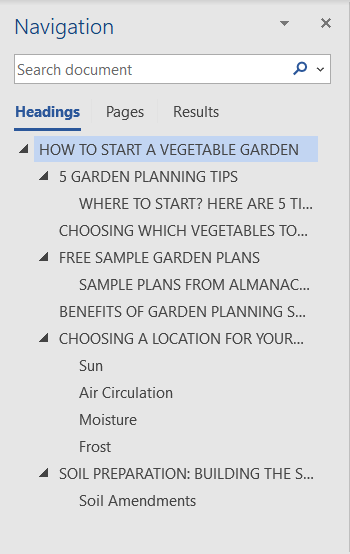Written by Allen Wyatt (last updated November 21, 2025)
This tip applies to Word 2007, 2010, 2013, 2016, 2019, and 2021
As you are working with large or complex documents, it is often easy to lose your place and spend a lot of time trying to find information. Word includes a tool that can help you navigate through your document quickly and easily. This tool is generally referred to as the Navigation pane, though if you are still using Word 2007 you may know it as the Document Map. (Microsoft changed the name from Document Map to Navigation pane with the introduction of Word 2010.)
Displaying the Navigation pane or the Document Map is easy. Start by displaying the View tab of the ribbon. Then, in the Show group (in Word 2007 look for the Show/Hide group) make sure the Navigation Pane or Document Map check box is selected. You follow these same steps to turn this feature on and off. You can also close the Navigation pane by clicking the X in the upper-right corner of the pane. (See Figure 1.)

Figure 1. The Navigation Pane.
You can tell when you are using either the Navigation pane or the Document Map because an outline of your document appears at the left side of the screen, with the document text at the right.
WordTips is your source for cost-effective Microsoft Word training. (Microsoft Word is the most popular word processing software in the world.) This tip (6029) applies to Microsoft Word 2007, 2010, 2013, 2016, 2019, and 2021.

Discover the Power of Microsoft Office This beginner-friendly guide reveals the expert tips and strategies you need to skyrocket your productivity and use Office 365 like a pro. Mastering software like Word, Excel, and PowerPoint is essential to be more efficient and advance your career. Simple lessons guide you through every step, providing the knowledge you need to get started. Check out Microsoft Office 365 For Beginners today!
Word allows you to enter citations and references within your document. If you need to develop these types of documents, ...
Discover MoreIf you establish dynamic links between documents, then you can force Word to update those links whenever you want. How ...
Discover MoreSometimes a writer needs motivation to keep ploughing ahead in their craft. Word doesn't really include any tools to help ...
Discover MoreFREE SERVICE: Get tips like this every week in WordTips, a free productivity newsletter. Enter your address and click "Subscribe."
2025-11-22 09:16:44
David in Mississippi
It seems you have totally ignored the keyboard shortcut to display this feature: CTRL-F. For me, this is a much easier way to get to this pane.
Sadly, I have been unable to make the (equivalent) CMD-F shortcut work on a Mac for this. But I haven't tried building my own shortcut for this - maybe I should. But good grief, Microsoft! Why not give us this shortcut intrinsically, like you do with the PC version!?
2025-11-21 07:03:27
Malcolm Patterson
Word's Navigation pane is more than just a presentation of the document's outline that can facilitate moving around in the document. It also allows the user to rearrange the headings (and associated text) in a manner similar to working in the Outline view: A heading in the Navigation pane can be dragged up or down to re-order the sequence of headings. The associated text (including subordinate headings) will move with it.
Got a version of Word that uses the ribbon interface (Word 2007 or later)? This site is for you! If you use an earlier version of Word, visit our WordTips site focusing on the menu interface.
Visit the WordTips channel on YouTube
FREE SERVICE: Get tips like this every week in WordTips, a free productivity newsletter. Enter your address and click "Subscribe."
Copyright © 2025 Sharon Parq Associates, Inc.
Comments